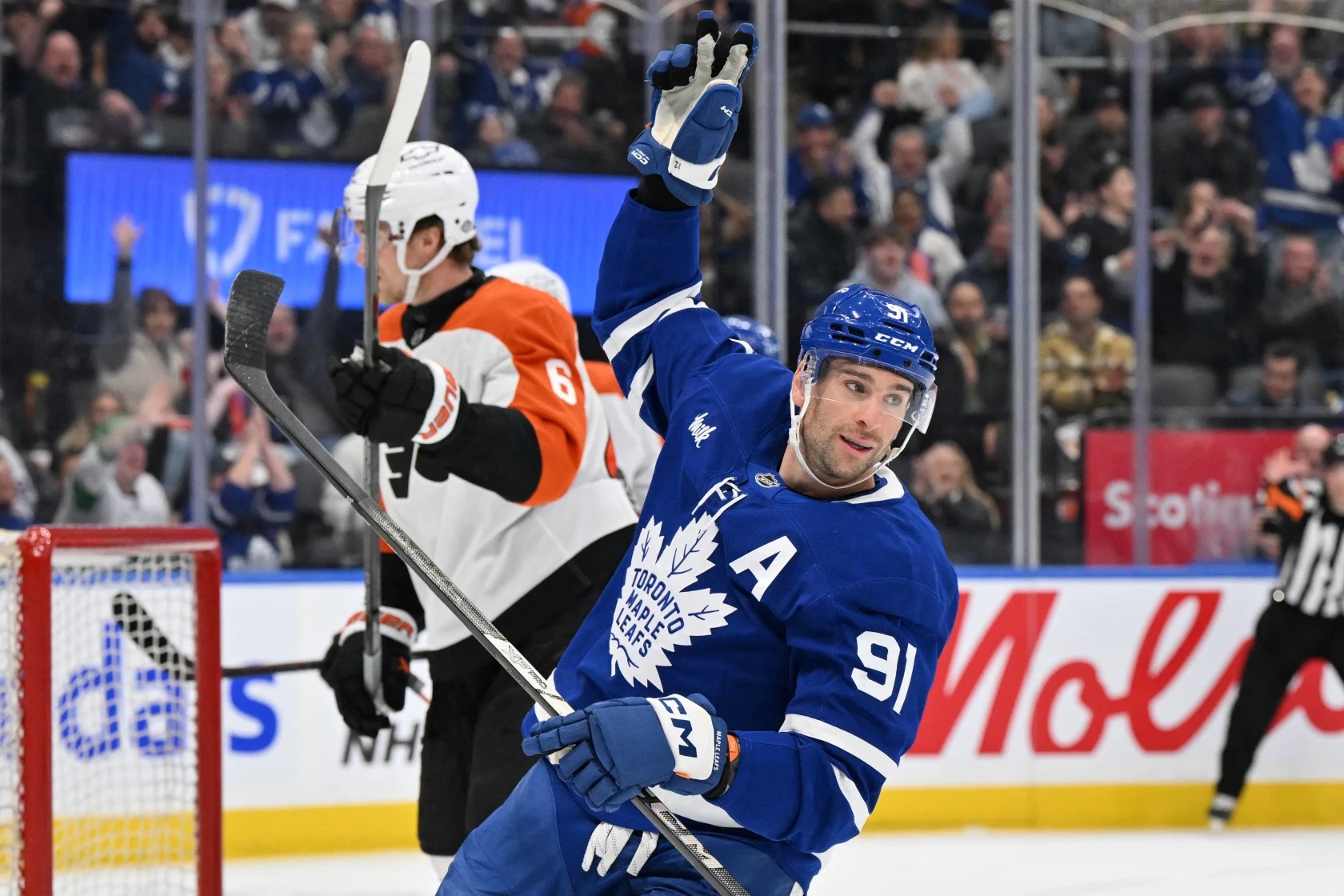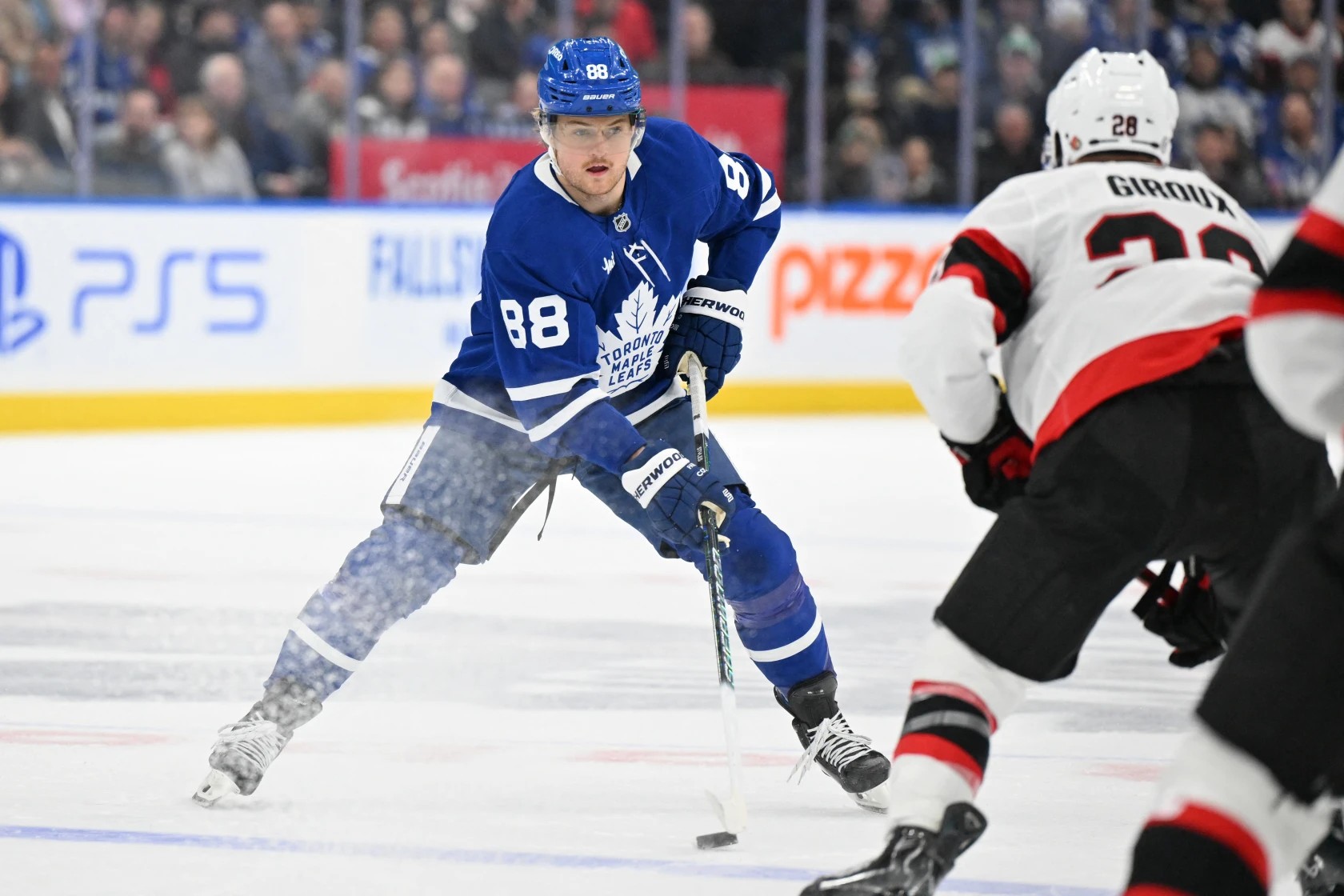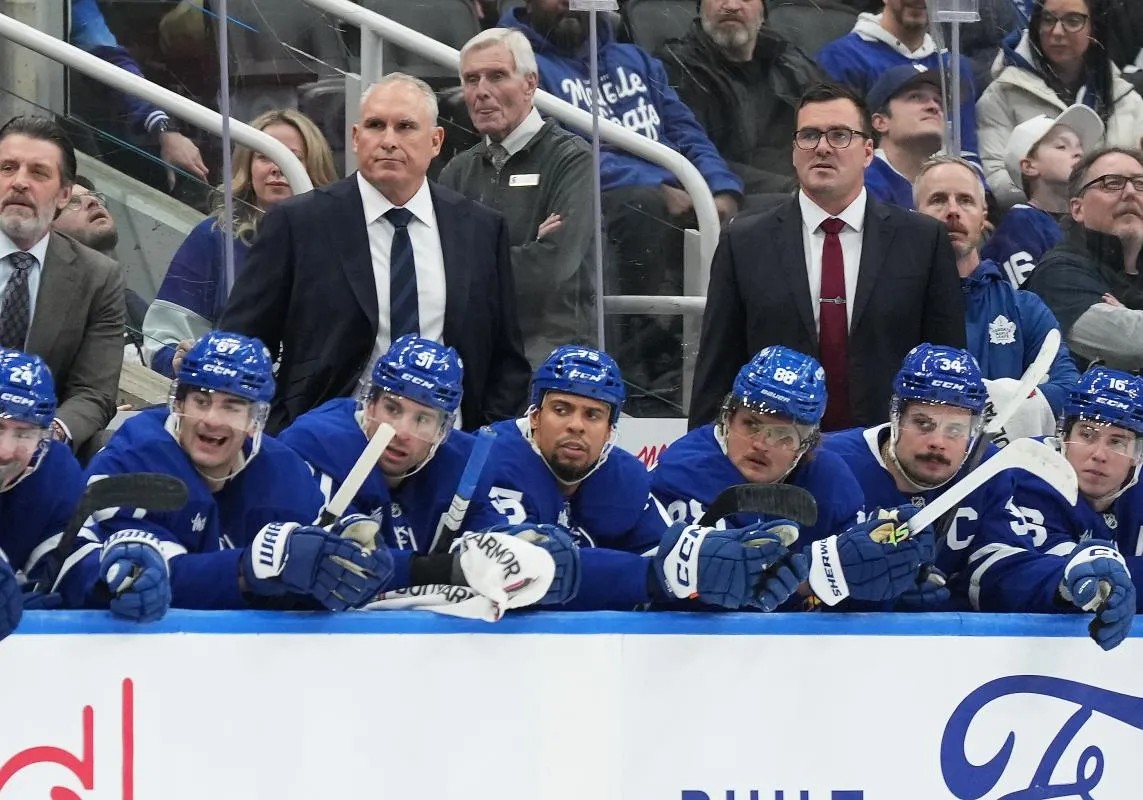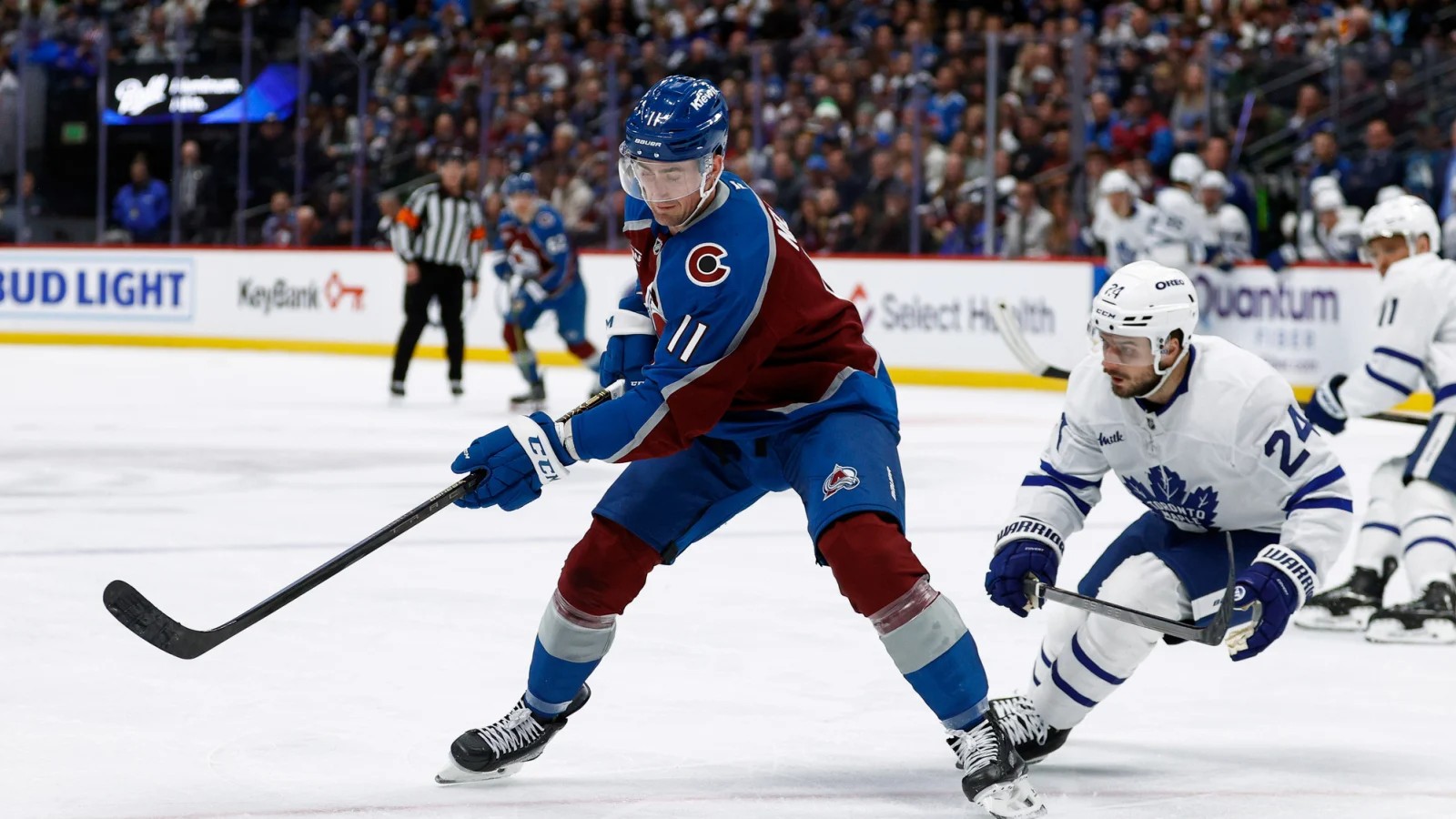During a week when the Maple Leafs took seven of eight points and reasserted themselves at the top of the Atlantic Division, one of their wins was particularly impressive.
The LA Kings own the best home record in the league—they had lost all of three times in regulation until the Leafs made it four on the back of a third-period comeback. It was a really good victory—one of their best of the season—and it shed light on how the Leafs may deploy their matchups in the playoffs.
One reason the Kings are so strong at home is their depth. They run an Anze Kopitar-Adrian Kempe top line, a Phillip Danault line with Trevor Moore that checks very well, and a Quinton Byfield-anchored third line, creating a matchup nightmare when they also own the last change.
The Panthers and Lightning don’t have the exact same lineup configuration, and they both have much better top-end talent. Still, the comparison is similar enough that it’s worth exploring as we monitor how the playoff matchups might play out.
The Leafs generally like to deploy their top line with Auston Matthews and Mitch Marner in a head-to-head role. Matthews and Marner have played some of the toughest minutes of any players in the league this year. However, a team like LA will not go head-to-head with an aging Kopitar against Matthews when they can control the matchups.
Instead, the Kings matched up their Danault-centered checking line against Matthews. I would imagine Tampa Bay — if the Leafs were to play them — would take the same approach with their Anthony Cirelli-led checking line. Florida, conversely, would go head-to-head with their Aleksander Barkov line, in all likelihood.
Either way, the Leafs‘ critical matchup becomes the John Tavares matchup. The Kings ran their top scoring line with Kopitar against them, and the Lightning would likely do the same with their Brayden Point line. For Florida, it would be their Sam Bennett-Matthew Tkachuk unit.
This is where we see the benefit of the Leafs acquiring Brandon Carlo. The Leafs adjusted their defense pairings to the matchups; the very first shift of the Kings game was a tell, as Tavares took the opening draw with Jake McCabe and Chris Tanev behind him (the Leafs’ primary shutdown pairing). That means Morgan Rielly and Carlo paired up with the Matthews line, which plays to their strengths; at that point, Rielly matches up against a checking line rather than a high-end scoring line.
Florida is such a tough matchup because their top center is an elite defensive player, and an elite scorer anchors their second line. They are a matchup nightmare and have won seven playoff series, accordingly, in the past two years.
The Leafs are essentially matching their shutdown pairing head to head and will either go all-in on the matchup in certain scenarios (for example, against Colorado, they had their top matchup pairing plus their top line together) or spread out those two combinations.
Notably, the Leafs went head-to-head with the Max Domi line against Quinton Byfield. I thought the Leafs might hedge this matchup with the David Kampf checking line, but Domi played more than double the next forward not on his line (Nylander) against Byfield. The main defenseman behind Domi was OEL, but after him, it wasn’t Simon Benoit; it was the McCabe-Tanev pairing.
The Leafs are moving OEL around, even though he is paired with Benoit on paper. OEL takes a lot of offensive-zone draws with Rielly, and the coaching staff generally shifts things around among their top five, depending on the situation.
Will a Domi-centered third line hold up against Tampa’s new third line, anchored by Yanni Gourde, or Florida’s third unit with Anton Lundell? It’s going to be a massive question down the line. Even Ottawa owns a good third line, centered by Shane Pinto. All of these division rivals are three lines deep.
The Leafs don’t appear to hedge it much with their checking line, preferring to generally go best on best with the first, second, and third lines. They match their defense pairs up and have their fourth line take as many defensive zone draws as possible (four of their five faceoffs in the LA game came in the defensive zone).
It’s all a chess game, and now that the deadline has passed and we know the roster, we’re starting to get a clearer indication of how the Leafs want to approach these matchups. They’ll get another chance to test it out against Florida on Wednesday, albeit without Matthew Tkachuk or Aaron Ekblad in the Panthers’ lineup. The Leafs are counting on their top guys to come through finally and their third/fourth line to not put them behind the eight ball (or their third pairing, which has done so with alarming regularity of late).
With several big games down the stretch to close out the regular season, it’s worth monitoring whether the Leafs will stick to this deployment or mix in some different looks.
Notes

– What a season John Tavares is putting together at the age of 34-35. He’s pacing for the third-highest goal per game and points per game outputs of his career. His shot is still as heavy and dangerous as ever, and if it feels like he’s scoring whenever he gets a look, it’s cause he generally is; he is shooting a career-high 19.8 percent, way above his career average of 13.2 percent.
It was also interesting to hear Sportsnet note, via Sportslogiq, that Tavares ranks second in puck battles won in the league. For all the talk of how Tavares would age, one thing worth flagging is that he has never been a strong skater, so his skating slowing down doesn’t have much impact on his game (he never had it). Tavares’ game has always been about heaviness below the circles, which is aging like a fine wine. In March, he piled up a monstrous 13 goals in 15 games.
– I was surprised to see Tavares is starting a career-low 45.95 percent of his shifts in the offensive zone. The speed of Bobby McMann and William Nylander on either side of him helps. That line is up 8-3 in goals so far while controlling the shot attempts (53.76 percent) and expected goals (63.34 percent).
McMann is an excellent F1 on the forecheck, coming in and making initial contact; instead of Tavares needing to skate up ice and get in there, he can follow up McMann as the F2 with his strength, and they can set the table for Nylander to do his thing.
The line has been a huge development for the Leafs. It is arguably their best second line of this era. Nylander is second in the league in goals, Tavares is ripping off a huge season, and McMann has joined the 20-goal club.
– In March, only Jake McCabe (21:33) played more per game than Oliver Ekman-Larsson (20:56). Chris Tanev played just 19:06 per game in March, his lowest ice time over a month this season. Last year, when Dallas traded for him at the deadline, they preserved his minutes as he logged just 19:13 per game in 19 regular-season games. In the playoffs, it shot up to 22:18 per game.
I have to imagine the Leafs are doing something similar. They can’t possibly think he’s fourth on the depth chart among this defense group. It may not seem like a lot, but the domino effect of Tanev playing an extra 2-3 minutes per game is significant, and I’d be surprised if the Leafs don’t re-jig these minutes once the playoffs begin.
– Last week on the MLHS podcast, we talked about the on-fire top power-play unit; they have led the league in power-play goals as a unit since 4 Nations, and the team hovered around 40 percent in March. The real concern with them is whether they will give offense back the other way, and last week, we saw some issues in this department.
The Leafs gave up a short-handed goal against San Jose. In the next game against LA, they almost got burned multiple times, as Mikey Anderson broke in all alone off a Byfield spin pass, and Adrian Kempe went on a botched 2v1. Much like how the Leafs use their top players on the PK, all the other top teams in the league also use their top players shorthanded. They must be diligent in this area and ensure they track back hard, knowing PKs will look to counterattack them.
Quotes

“That’s pretty cool, but my focus is on the playoffs right now. That’s obviously fun to accomplish that, playing with great players, but what matters is the playoffs.”
– William Nylander on hitting the 40 goal mark for the third straight year
We probably haven’t given William Nylander enough flowers for his goal-scoring this season. He’s second in the league in goals and has passed the 40-goal mark for the first time in his career. He’s played nearly 250 five-on-five minutes with Pontus Holmberg this season and has over 200 with Max Pacioretty, two players who have combined for all of 28 points this season. They’ve put him behind the eight ball multiple times in terms of his linemates, but it doesn’t matter; he continues to score goals.
We’re probably a little numb to elite goal-scoring because of Matthews (and even the Tavares’ 48-goal season), but Nylander is one of the best in the league at putting the puck in the net. The best thing is that he doesn’t care about any of those stats. He knows it’s about winning.
“They have had some good games. They both defend hard and are both physical players. They are an effective pair when they are simple with the puck getting it up to the forwards. They are a difficult pair to play against, to be honest with you, with the size and physicality they both play with. I don’t love OEL on his offside, but that is the way it is with that pair right now.”
Craig Berube on the Benoit – OEL pair
Fairly protective and tight-lipped with his thoughts all season long, Craig Berube pretty bluntly noted he doesn’t love Oliver Ekman-Larsson on the right side.
It’s not a controversial comment. We have mentioned it many times, and it is probably obvious to all onlookers that OEL is better on the left. If he is notably better on the left, is Philippe Myers that much worse than Simon Benoit as an overall player that they’re willing to take the hit on worsening OEL’s impact?
Suppose it’s even close to negligible at five-on-five (and a decent argument can be made there). Is Benoit such an integral second-unit left-side penalty killer on a mediocre penalty-killing unit — and he is better on the PK than Myers, for sure — that it justifies it?
“Being a younger guy to come out of college, I wanted a place that would really develop me and somewhere with opportunity as well.”
– Luke Haymes
The Leafs are starting to build a pretty good track record of developing college free agents. Bobby McMann is excelling with the big club right now, while Alex Steeves is one of the best players in the AHL. Trevor Moore has carved out a really good career with the Kings. Last year’s college signing Jacob Quillan has shown tremendous growth through the season and looks like a legitimate NHL prospect. The list goes on and on at this point.
Add in that the Leafs American League franchise is located in Toronto — meaning, players can live in the same city regardless of what team they play on — and all the resources the Leafs have at their disposal in terms of facilities, medical staff, accommodations, etc. Getting these players to pick Toronto is a pretty straightforward sales job.
Luke Haymes is the most promising of the three college free agents the Leafs signed, given his age (21), production, and profile (a big center who can skate). It’s a good haul for the Leafs’ management group, and the recruitment effort dates back to last season when they brought Haymes to their development camp. Recruiting is a 24/7/365 process, and they must always be on it as they trade draft picks away each season.
Haymes and John Prokop have already debuted with the Marlies, and eventually, Luke Kirwan will as well. Next season, Easton Cowan should join them. Quillan’s breaking out down the stretch, and William Villeneuve is quietly enjoying a promising season. Despite the organization trading away Fraser Minten and Nikita Grebenkin at the deadline, there are some intriguing players on the Marlies to keep an eye on.
Tweets of the Week

Shot quality should be on every game summary / scoreboard.
Maple Leafs vs Kings
Shots: 36-26 LA
Slot Shots: 17-9 TOR
Goals: 3-1 TOR
via @Sportlogiq— Mike Kelly (@MikeKellyNHL) March 30, 2025
This is a good example of how shot totals can be misleading and how the Leafs prioritize the slot in the offensive and defensive zones. They are happy to allow teams the outside shots and box out. They can also create legitimate offense inside the “house.”
At the same time, at five-on-five, during the busy month of March where they played 15 games, they had the second-worst Corsi in the league, ahead of only the Blackhawks. Their expected goals rate was 26th, and they got outscored at five-on-five 33-31.
The Leafs ultimately went 8-5-1 in March on the back of a power play that clicked at 39.5 percent (third best), and they enter April in control of their destiny in the Atlantic. Still, these are some very leaky numbers that won’t be sustainable every other night against the Panthers and Lightning of the league.
Some stuff on the Leafs D from @Sportlogiq.
Looked into Rielly's gap control. Of 159 D-men to play 800 mins this year, his avg gap distance is 13.0 feet, 143rd in the league. Funny though, that stat isn't directly tied to "DZ Denial rate," where he's actually just fine (46th).…
— Justin Bourne (@jtbourne) March 28, 2025
Those are interesting numbers on the Leafs’ neutral zone defense and gap control. The Leafs are generally very good at defending off the rush and don’t give up much in that category. To me, their issues in defending and controlling play stem from not breaking out cleanly and not sustaining offensive-zone pressure.
Offensively, there are a lot of one-and-dones. They don’t consistently generate extended offensive-zone shifts by recovering enough pucks and grinding on the walls.
Defensively, they chip a lot of pucks off the glass and out. Against Anaheim, there were a few plays where wingers were wide open ahead of a defenseman, but they still put it off the glass rather than making a tape-to-tape pass. There are definitely times to go off the glass — I don’t believe it’s always a bad play — but there’s a difference between getting the puck out under duress and passing up a clean pass at a systemic level.
#Leafs practice is underway, being run by associate coach Lane Lambert.
Auston Matthews and Mitch Marner are not taking part. Told it’s optional for them after the minutes they logged.
Marner (25:26) Matthews (25:07) pic.twitter.com/jfYXzzK139
— David Alter (@dalter) March 28, 2025
I asked David Alter about this, and he confirmed that Auston Matthews and Mitch Marner were the only two who didn’t participate. On the one hand, I get the frustration that the Leafs’ top two players weren’t on the ice after a fairly mediocre performance against a bottom-feeder where they were outscored at five-on-five (even if they did tie it late). In particular, you want to see your captain on the ice the next day.
On the flip side, if they reward the coach for the time off, I have difficulty complaining. Against the Kings, they took the game over as it went along, with Marner springing Matthews on a play that ultimately tied the game before Matthews drew a penalty that led to his primary assist on the game-winner. They closed the game and did a great job locking it down as the Leafs picked up an insurance marker.
The next night in Anaheim, they scored a disallowed goal (Knies), Marner scored, and they once again closed out the win.
There has to be some give and take, but if they are going to rise to the occasion, fair enough. This is how many teams manage their stars who have huge workloads; it is not uncommon.
Five Things I Think I’d Do

1. If the Leafs are going to commit roughly to these lines — and it appears they are — they really need to see more out of the end result at five-on-five. They aren’t controlling play enough or winning the five-on-five minutes consistently. Their red-hot power play is masking over some of these issues right now, and they should be honest about this rather than feeling the need to keep a winning lineup together without tweaks.
The game against Florida will be telling. Following a few days off, they need a good process that leads to a good result at home against a tired Panthers team without Aaron Ekblad and Matthew Tkachuk.
2. Along those lines, I would like to see Scott Laughton back at center. Even if it’s with the same linemates, I think he’s better defensively and more committed to his own side of the ice than Max Domi.
Domi’s goal against Anaheim is a good example. Laughton was effectively low and playing center on the sequence. He anticipated where the puck was going, cut it off, and head-manned the rush. Given that he was on the wing, Domi was able to break up the ice.
3. I think I like the proper handedness throughout the Leafs’ top nine with Calle Jarnkrok up on the third line. Jarnkrok quietly has five points in 11 games this season, which is reasonable secondary scoring (although he only has one goal). Passing sequences are a little easier when players are on their proper side, and he’s responsible defensively while able to move the puck well enough offensively.
It didn’t look good when Nylander moved to his left, and the Leafs have had a bunch of left-handed shots play on the right all season. I can’t think of any of them really benefiting from playing their offside on even one sequence of note (as if they are Alex Ovechkin or something).
4. I think I wish the Leafs valued this handedness throughout their defense, too. It’s wild that Philippe Myers hasn’t played since March 10. I’ve written about this enough, but obviously, I’d give him a look. At this point, the unfortunate thing is that he hasn’t played in so long and it has been talked about so much that the expectations will be out of whack when it eventually happens. They’ll likely revert it instead of giving it some real run, just as they did when they spread out three forward lines for all of one game.
5. I think I would give Anthony Stolarz the Panthers game and Joseph Woll the Columbus game, no matter what.

































